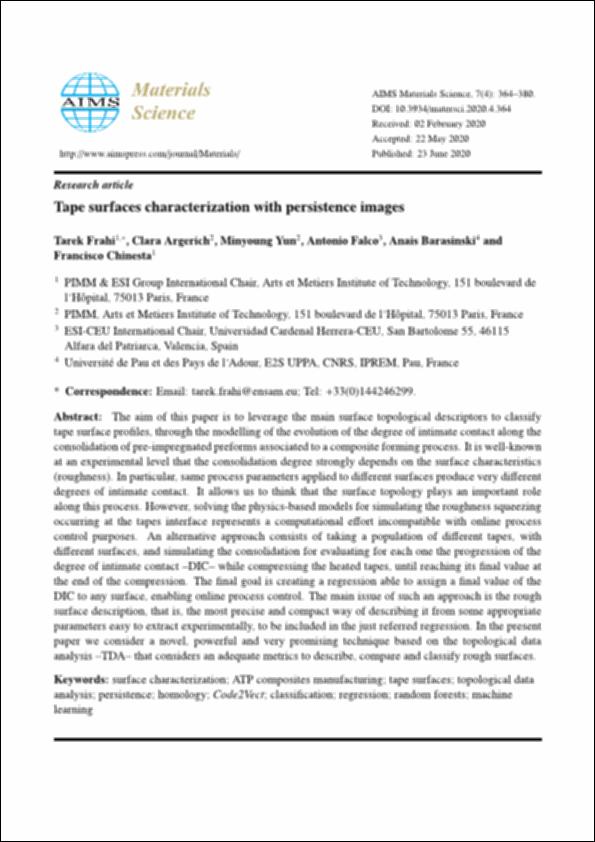Please use this identifier to cite or link to this item:
http://hdl.handle.net/10637/12455Tape surfaces characterization with persistence images
| Title: | Tape surfaces characterization with persistence images |
| Authors : | Frahi, Tarek Argerich Martín, Clara Yun, Minyoung Falcó Montesinos, Antonio Barasinski, Anais Chinesta, Francisco |
| Keywords: | Thin films.; Películas delgadas.; Superficies (Tecnología) - Modelos matemáticos.; Composite materials.; Surfaces (Technology) - Mathematical models.; Materiales compuestos. |
| Publisher: | AIMS. |
| Citation: | Frahi, T., Argerich, C., Yun, M., Falco, A., Barasinski, A. & Chinesta, F. (2020).Tape surfaces characterization with persistence images. AIMS Materials Science, vol. 7, i. 4 (23 jun.), pp. 364-380. DOI: http://dx.doi.org/10.3934/matersci.2020.4.364 |
| Abstract: | The aim of this paper is to leverage the main surface topological descriptors to classify tape surface profiles, through the modelling of the evolution of the degree of intimate contact along the consolidation of pre-impregnated preforms associated to a composite forming process. It is well-known at an experimental level that the consolidation degree strongly depends on the surface characteristics (roughness). In particular, same process parameters applied to di erent surfaces produce very di erent degrees of intimate contact. It allows us to think that the surface topology plays an important role along this process. However, solving the physics-based models for simulating the roughness squeezing occurring at the tapes interface represents a computational e ort incompatible with online process control purposes. An alternative approach consists of taking a population of di erent tapes, with di erent surfaces, and simulating the consolidation for evaluating for each one the progression of the degree of intimate contact –DIC– while compressing the heated tapes, until reaching its final value at the end of the compression. The final goal is creating a regression able to assign a final value of the DIC to any surface, enabling online process control. The main issue of such an approach is the rough surface description, that is, the most precise and compact way of describing it from some appropriate parameters easy to extract experimentally, to be included in the just referred regression. In the present paper we consider a novel, powerful and very promising technique based on the topological data analysis –TDA– that considers an adequate metrics to describe, compare and classify rough surfaces. |
| Description: | Este artículo se encuentra disponible en la siguiente URL: http://www.aimspress.com/article/10.3934/matersci.2020.4.364 |
| URI: | http://hdl.handle.net/10637/12455 |
| Rights : | http://creativecommons.org/licenses/by/4.0/deed.es |
| ISSN: | 2372-0484 (Electrónico) |
| Issue Date: | 23-Jun-2020 |
| Center : | Universidad Cardenal Herrera-CEU |
| Appears in Collections: | Dpto. Matemáticas, Física y Ciencias Tecnológicas |
Items in DSpace are protected by copyright, with all rights reserved, unless otherwise indicated.


